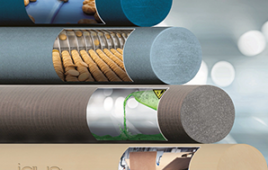The M-1 “steel-pot” helmet was first adopted by the U.S. military in 1941. Besides its use as a helmet, the gear was also used as a cooking pot, bucket, shaving sink, and headrest. However, about the only resemblance today’s military helmets have to the old steel pot is the head-like shape. The modern soldier has gear that offers more protection at a lighter weight and with more versatility than before.
The Future Assault Shell Technology (FAST) bump helmet utilizes advanced materials to provide lightweight head protection for today’s advanced fighter. The U.S. Military’s Special Operations Command was looking for a helmet designed for impact protection more than ballistic protection. It could also be used for a rescue operation, parachuting, reconnaissance missions, or for training.
Based on ASTM F 1492 standards for multiple impact resistance, the FAST bump helmet is also designed to be stiff and versatile enough to hold night-vision goggles, gas masks, cameras, lights, sensors, or anything else a soldier might need.
Artisent, Inc., designs and manufactures helmets for both the military and sports-protection markets. Together with its production wing Ops-Core, the two companies introduced the FAST helmet system.
The FAST helmet is made of a carbon fiber and nylon co-weave. This combination of materials gives Artisent designers and engineers the optimal combination of rigidity and impact resistance for this application. The exact ratios of carbon fiber to nylon are proprietary, but the carbon fibers used run the full length of the helmet. As a general rule, increasing the length of carbon fibers improves tensile and flexural strength.
Since this version of the FAST helmet does not need to provide ballistic protection, Ops-Core created a very lightweight product. With all accessory mounting hardware included, the helmet weighs 638-744 gr, depending on the size.

The complete FAST helmet after machining.
Artisent worked with Mike Murray, owner of Lakeside Design of Massachusetts, to design and build the fixturing and write the CNC programming code for the milling machine used in the manufacture of the helmets. This code included the 3D paths for drilling ventilation holes in the helmets.
Murray used a Tormach 1100 PCNC mill for all the prototyping work and to prove out the designs. The prototyping worked out so well that Artisent bought a Tormach mill and fourth axis for actual production.
The manufacturing process begins with sheets of a carbon fiber and nylon matrix. The sheets are cut to approximate size and set in layers. The stacked sheets are placed into a mold where they are heated until they conform to the shape of the mold. The nylon melts during this process and serves as a binder to hold all the layers of fabric together, as well as provide structural integrity.
The basic helmet form is removed and cooled and the edges are trimmed with a CNC lathe. Next, ventilation holes are added. The shell is mounted into a fixture custom-made for this manufacturing process.

Machining ventilation holes on the Tormach PCNC 1100 with 4th axis.
For the fixturing, Murray designed a 35° angle plate to be bolted to the bed of the Tormach mill. A fourth axis unit was attached to the mounting plate, which precisely rotated the work piece in a circle along the plane of the 35° angle. Finally, using a fused deposition modeling (FDM) process, Artisent made a holder out of polycarbonate plastic that matches the contours of the helmet. This plastic holder mounts to the fourth-axis. To mill the ventilation holes, an operator slips the shell into the polycarbonate receiver and starts the mill. Using a two-flute carbide mill/drill bit at 4500 rpm with a feed rate of 35 in./min, the mill completes a 3D contour of all the ventilation holes in a single helmet in approximately two minutes.
Subsequent manufacturing processes smooth all the shell’s edges. Then, it is coated using a proprietary chemical agent resistant coating (CARC) which makes the helmet easier to decontaminate if it is exposed to a chemical weapon.
A bump helmet is designed to reduce the forces of any impact or concussive force transmitted to the head of the wearer. All the parts, such as the shell, padding, and straps must absorb or deflect incoming forces. The force of an impact is measured in gs.

Custom work-holding was designed and built for each size helmet.
Conventional wisdom holds that it takes a minimum force of around 75 gs to cause a traumatic brain injury such as a concussion. But recent tests conducted with accelerometers inside the helmets of football players have determined this not to be the case. Some impacts as low as 60 gs have caused concussions while impact forces as high as 150 gs have not.
In the U.S., helmets are tested by the Consumer Products Safety Commission (CSPC) and must meet a standard of no greater than 300 gs under test conditions. The FAST helmet meets a standard of no more than 150 gs during a 10 ft/s impact and not more than 200 gs during a 14 ft/s impact.
The original “steel pot” helmet of the 1940s was designed to protect against bullets and shrapnel, and it saved many lives during the forty-plus years it was in service. The newest generations of helmets are designed to help counter the effects of new threats such as the percussive blast of an Improvised Explosive Device (IED).
Artisent, Inc.
www.artisent.com
Tormach
www.tormach.com
Filed Under: Materials • advanced





Tell Us What You Think!